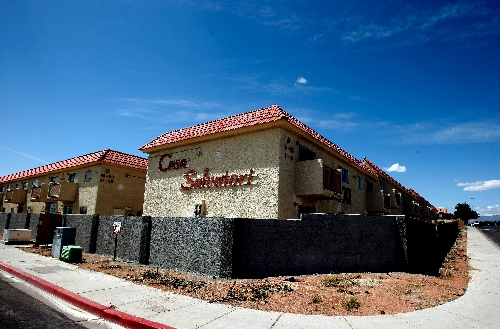Apartment rental rates climb as jobs market improves

Apartment rents in Las Vegas rose slightly in the first quarter, part of a national trend in which 36 of 41 metropolitan statistical areas showed an increase in rents, California-based RealFacts reported Tuesday.
Average rent in Las Vegas climbed 0.9 percent from the previous period to $775 a month, though it’s still down 10.4 percent from $865 a year ago.
RealFacts’ survey of apartment complexes with 100 or more units put the national average rent at $943, up from $932 in the fourth quarter.
Rental housing fundamentals seem to have improved virtually overnight, company spokeswoman Sarah Bridge said.
In December, the outlook for apartments was "positively grim," she said. Las Vegas rents declined 8.2 percent in the fourth quarter.
Employment is an important indicator for rental housing, with a direct correlation between the unemployment rate and apartment vacancy. Las Vegas has always been a market that’s particularly sensitive to the employment situation, Bridge said.
"The reason rents are on the rise after five consecutive quarters of decline is due to a modest increase in the rate of employment and new jobs being created in many markets," she said. "That said, Las Vegas is one of the markets hardest hit by the current economic downturn."
Rental housing has responded to the uptick in employment by posting equally modest gains in rents and occupancy. Unemployment numbers are still climbing in some markets, primarily because people who had given up looking for work are now re-entering the labor market with a renewed sense of optimism, Bridge said.
Several markets posted rent increases in excess of 2 percent, led by Charlotte, N.C., at 4.6 percent; Phoenix at 4.5 percent; Baltimore and Denver at 3.5 percent; Salt Lake City at 3.4 percent; and San Antonio at 2.4 percent.
Other markets are still far from becoming an "overnight sensation," Bridge said. Atlanta lost 3.4 percent and Durham, N.C., lost 2.4 percent.
Occupancy rates haven’t rebounded as quickly as rental rates, but stabilization has been firmly established early in the year, Bridge said. The most promising market was Fresno, Calif., which gained 2.4 percentage points in first-quarter occupancy to 92.5 percent.
Average occupancy in Las Vegas improved to 90.5 percent during the quarter, up 0.4 percentage points from the fourth quarter. It’s down from 91.2 percent a year ago.
Spence Ballif, apartment specialist with CB Richard Ellis brokerage in Las Vegas, reported 10.37 percent vacancy in March, down from 10.41 percent in February. Class A apartments, or higher-end rentals, showed 7.24 percent vacancy for 35,198 units; Class B vacancy was 10.39 percent for 45,614 units; and Class C vacancy was 14.1 percent for 29,161 units.
Apartments are competing with a flood of single-family rental homes on the market, he said.
"The market is still quite soft, no question," Ballif said. "Rental homes are the biggest competing factor for apartments and the number of investors buying homes in the market is not slowing down, as far as we can tell. On the other hand, many of the foreclosures in the market are from the initial batch of investors that purchased homes early on in the cycle when loans were available to them and they can no longer make the payments. It’s very difficult to determine the net impact of the investment homes."
Many experts predicted modest growth for rental housing this year, but are placing their belief in 2011 as the time where they will reap the benefits of sustained growth and value appreciation for apartments.
Patrick Sauter of Sauter Cos. in Las Vegas recently sold the 50-unit Casa Salvatori apartment complex for $1.45 million, or about $30,000 a unit. The bank-owned property, built in 1984, was about 50 percent leased and needs paint, landscaping and interior work. He closed the all-cash transaction with a private investor in less than 10 days.
Sauter said he’s definitely seeing an uptick in interest from investors looking at Las Vegas. Smaller properties especially are starting to trade, he said.
"We think we’ve bottomed out," Sauter said. "We don’t see a lot of growth in the next 12 to 18 months. Rents are stable. Good operators that adjust to the market can stay in the low 90s for occupancy. For the environment we’re in, that’s pretty good."
Construction of apartment units has leveled off. RealFacts reported 32,556 units were added in 2009, nearly identical to the prior year. This represents a mere 1 percent increase to the overall supply of 3.27 million rental units.
Most of the development occurred in Texas, a state that has shown promising growth indicators such as increased population and job creation in the emerging field of energy, Bridge said. San Antonio, Houston and Dallas were able swallow 8,667 units without a hiccup, she said.
Contact reporter Hubble Smith at hsmith@reviewjournal.com or 702-383-0491.